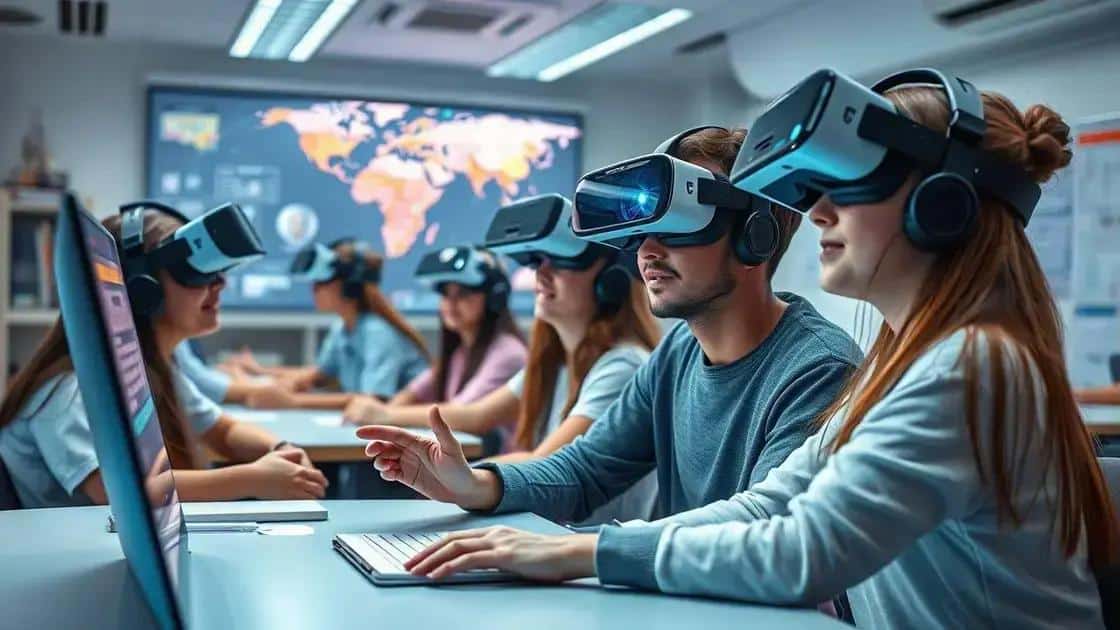Insights on vr learning environments for better engagement

VR learning environments enhance education by providing immersive, engaging experiences that improve student participation, promote collaboration, and offer personalized learning opportunities, while addressing challenges like cost and technical requirements.
Insights on vr learning environments reveal a transformative approach to education. Have you ever wondered how these immersive experiences can revolutionize traditional learning? Let’s dive in!
Understanding virtual reality in education
Understanding virtual reality in education is crucial for harnessing its full potential. As educational institutions explore new methods, VR technology offers immersive experiences that can enhance learning.
This technology allows students to engage with complex subjects in an interactive way. Imagine exploring ancient ruins or conducting scientific experiments without leaving the classroom. Such experiences make learning memorable and impactful.
The Basics of VR in Education
At its core, virtual reality creates a simulated environment that users can interact with. This technology can capture attention and motivate students by providing:
1. Hands-on learning experiences
2. Safe environments for complex scenarios
3. Increased retention through immersive scenarios
The classroom dynamics change significantly with VR. Students can collaborate in these spaces, working together to solve problems or create projects. Using VR headsets, they can communicate and interact, even when physically apart.
Real-World Applications
Various fields are adopting virtual reality for enhanced educational outcomes. For example, in healthcare, medical students can practice surgeries in a risk-free environment. Similarly, in architecture, students use VR to walk through their designs.
Some advantages of using VR in education include:
These applications reflect a shift in how we perceive learning. Rather than passively receiving information, students actively participate in their education. This shift encourages deeper understanding and greater interest in subjects.
In conclusion, the integration of virtual reality in education is reshaping learning experiences. By embracing these technologies, educators can prepare students for a future that increasingly relies on immersive and interactive methods.
Benefits of vr learning environments

The benefits of VR learning environments are significant for both educators and students. By bringing lessons to life, these immersive spaces enhance understanding and retention.
With VR, students can explore complex concepts, making abstract ideas much more concrete. For instance, in a history class, learners might walk through ancient civilizations, experiencing the past in a way that textbooks cannot provide.
Enhanced Engagement
One of the standout advantages is enhanced student engagement. When learning feels like an adventure, students are more likely to participate actively. In these environments, learners get to:
- Interact with 3D models of scientific phenomena.
- Simulate real-life scenarios for practical skill application.
- Collaborate with peers on projects within immersive worlds.
This interactive approach transforms the typical classroom experience, capturing students’ attention and motivating them to delve deeper into subjects.
Improved Learning Outcomes
Research suggests that VR learning environments lead to better learning outcomes. Students retain information longer and grasp concepts more firmly compared to traditional learning methods. This technology caters to different learning styles by enabling:
- Visual learning through rich graphics.
- Kinesthetic learning with hands-on activities.
- Auditory learning from immersive narratives.
When learners can visualize and practice what they are studying, their understanding improves significantly. This multifaceted approach also helps in developing critical thinking and problem-solving skills as students face challenges in simulated environments.
In summary, the integration of virtual reality in educational settings is not just about technology; it’s about creating engaging, effective, and inclusive learning experiences. These environments foster curiosity and encourage innovation, paving the way for a new era in education.
Challenges in implementing vr systems
Implementing VR systems in educational settings presents several challenges that institutions must navigate. While the benefits are clear, there are obstacles that can delay or complicate integration.
One major challenge is the cost associated with acquiring the technology. Virtual reality headsets and software can be expensive, making it difficult for schools with limited budgets to adopt these systems. The initial investment can be a significant barrier, especially for smaller institutions.
Technical Requirements
VR systems also require significant technical infrastructure. Schools need to ensure they have:
- High-quality computers or devices capable of running VR applications.
- Stable internet connections to support online functionalities.
- Space for VR activities, ensuring safety and comfort for students.
This setup can be daunting for many institutions, particularly those that may not have adequate IT support or funding for upgrades.
Training and Support
Another challenge is training educators to effectively use VR technology. Teachers must understand not only how to operate the equipment but also how to integrate it into their lessons. Professional development opportunities must be provided to ensure staff feels confident in using these systems.
Furthermore, ongoing support is crucial. If technical issues arise, schools may find themselves without immediate assistance, leading to frustration and lost instructional time. This support is essential for maintaining the effectiveness of VR systems in the classroom.
Finally, there is the challenge of creating engaging content that aligns with curriculum standards. As technology evolves, materials must be regularly updated to remain relevant and effective for learning purposes. This requirement places additional demands on educators and content developers alike.
Future trends in vr education

Future trends in VR education promise to reshape how students learn and educators teach. As technology continues to evolve, so do the possibilities that virtual reality brings to the classroom.
One expected trend is the integration of artificial intelligence with VR. This combination can create personalized learning experiences for each student. With AI, VR environments can adapt in real-time to suit individual learning paces and styles, enhancing overall engagement and effectiveness.
Expanded Content Libraries
Another trend is the expansion of content libraries available for VR education. Educational institutions are increasingly collaborating with tech companies to develop immersive content. This will provide students access to:
- Diverse subjects and courses beyond traditional curriculums.
- Interactive simulations that allow for practical applications.
- Constantly updated resources that reflect current events and advancements.
Such resources can empower students to explore interdisciplinary themes, fostering critical thinking and innovation.
Global Learning Opportunities
The future also holds the potential for global learning opportunities. VR can connect students from different parts of the world, enabling them to collaborate on projects in real-time. Students could attend virtual classes or engage in cross-cultural exchanges, enriching their educational experiences.
This connectivity can lead to a greater understanding of global perspectives and issues, fostering empathy and teamwork among young learners. The classroom will extend far beyond local borders, creating a genuine global learning community.
In addition, as the technology becomes more accessible, schools in underserved areas will have the chance to adopt VR tools, leveling the playing field for all students. This equitable access to innovative learning technology will be crucial in the coming years.
FAQ – Frequently Asked Questions about VR Learning Environments
What are the key benefits of using VR in education?
VR enhances engagement, improves learning outcomes, and provides personalized experiences that cater to different learning styles.
How does VR facilitate global learning opportunities?
VR allows students to connect with peers from around the world, promoting collaboration and cross-cultural exchanges.
What challenges do schools face when implementing VR systems?
Challenges include high costs, technical requirements, and the need for teacher training and ongoing support.
What future trends should we expect for VR in education?
Future trends include the integration of AI, expanded content libraries, and increased accessibility for underserved schools.





